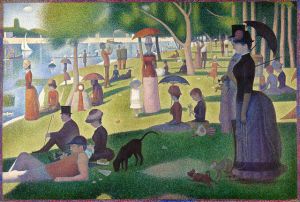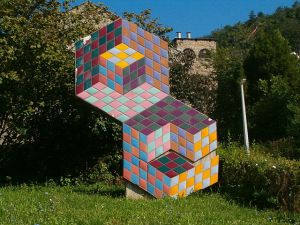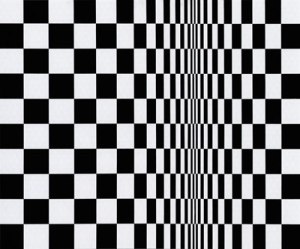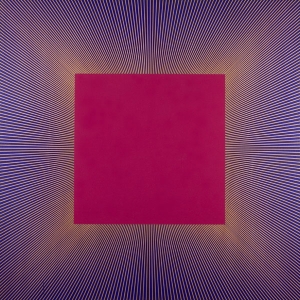OP art is a genre that I had not researched much in the past, or indeed enjoyed looking at that much. I remember during my A level in art researching juxtaposing pointillism and doing exercises in painting in the style of Georges Seurat,
Probably one of the most known examples being “A Sunday on La Grande Jatte” by Georges Seurat in 1884.Seurat used optical mixin, whereby small specks of pure colour laid side by side merge together when viewed from a distance. By combining colours the trick of the eye is to create a third colour that does not exist on the canvas.
Op art interacts with the viewer in a similar way by creating optical illusions. OP art artists have different approaches to their illusions, but all aim to create a new dimension to their work that does not, in fact exist.
Victor Vasarely
Victor Vasarely was one of the ‘fathers’ of Op art. He used a variety of materials with limited forms and colors, throughout his career. . Vasarely went on to develop his’ kinetic’ images, which were superimposed on panes of glass creating different viewpoints and moving impressions.
Bridget Riley
INSERT MY PHOTO HERE
Living in Birmingham, I am fortunate to be able to see a Bridget Riley in Birmingham’s art gallery – ‘Cherry Autumn’ 1983 A very large painting inspired by autumn leaves of a cherry tree against the backdrop of a blue sky.
Known as the mother of Pop art, Bridget Riley further developed Victor Vasarely’s style, known for her black and white pieces, which play on geometric forms. These works produce the sensation of movement and color.
Richard Anuszkiewicz
Richard Anuszkiewicz was one of the founders of the Op art movement. Anuszkiewicz’s style was to use of complementary colours, which pronounced the geometry of his pieces. Anuszkiewicz’ played with the effects of opposing colors on one geometric form. An example is “Deep Magenta Square,” which contrasts a bold magenta square against a background of radiating lines.
References
http://en.wikipedia.org/wiki/Op_art
“Hungary pecs – vasarely0”. Licensed under Creative Commons Attribution-Share Alike 3.0 via Wikimedia Commons – http://commons.wikimedia.org/wiki/File:Hungary_pecs_-_vasarely0.jpg#mediaviewer/File:Hungary_pecs_-_vasarely0.jpg
.”A Sunday on La Grande Jatte, Georges Seurat, 1884″ by Georges Seurat – Art Institute of Chicago. Licensed under Public domain via Wikimedia Commons – http://commons.wikimedia.org/wiki/File:A_Sunday_on_La_Grande_Jatte,_Georges_Seurat,_1884.jpg#mediaviewer/File:A_Sunday_on_La_Grande_Jatte,_Georges_Seurat,_1884.jpg
“Riley, Movement in Squares”. Via Wikipedia – http://en.wikipedia.org/wiki/File:Riley,_Movement_in_Squares.jpg#mediaviewer/File:Riley,_Movement_in_Squares.jpg
“Deep-Magenta-Square,-1978”. Via Wikipedia – http://en.wikipedia.org/wiki/File:Deep-Magenta-Square,-1978.jpg#mediaviewer/File:Deep-Magenta-Square,-1978.jpg
“Hungary pecs – vasarely0”. Licensed under Creative Commons Attribution-Share Alike 3.0 via Wikimedia Commons – http://commons.wikimedia.org/wiki/File:Hungary_pecs_-_vasarely0.jpg#mediaviewer/File:Hungary_pecs_-_vasarely0.jpg



